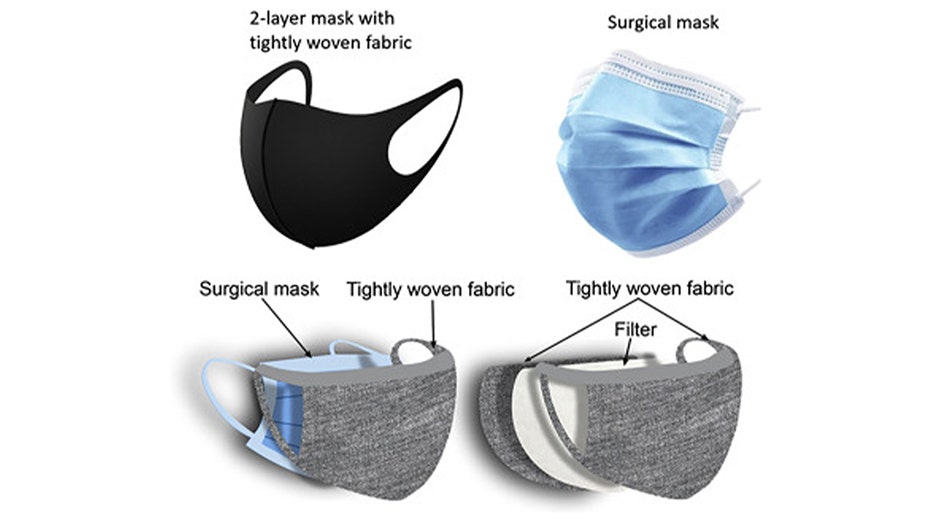Double mask: Fauci says wearing 2 masks may offer more protection from COVID-19
LOS ANGELES - The science on masks amid the novel coronavirus pandemic has rapidly evolved, and researchers have continued to surface more and more evidence proving their effectiveness. Now, some medical experts are saying two masks are even better than one.
On Monday, in an interview with the TODAY show, Dr. Anthony Fauci, the nation’s leading expert on infectious diseases, said, "If you have a physical covering with one layer, you put another layer on, it just makes common sense that it likely would be more effective."
"That’s the reason why you see people either double masking or doing a version of an N95," he added.
The U.S. Centers for Disease Control and Prevention doesn’t explicitly state that people should double up on facial coverings, but the health agency says multi-layer cloth masks can block up to 70% of respiratory droplets that can carry the deadly virus.
"Multiple layers of cloth with higher thread counts have demonstrated superior performance compared to single layers of cloth with lower thread counts," the CDC wrote in a report on cloth masks published Nov. 20, 2020.
During the onset of the COVID-19 pandemic last year, thousands of individuals and organizations answered the call to produce homemade facial coverings amid serious shortages of medical supplies and PPE at the time.
RELATED: Desperate hunt for medical gear to fight COVID-19 becomes all-consuming
But researchers found that some masks were more effective than others, and the material used to make them matters.
While N95 masks were reported to achieve up to 97% filtration of unwanted particles, researchers found that some homemade masks demonstrated as little as 1% filtration.
RELATED: If you’re going to make your own face mask, the material matters, researchers say
Researchers at the Wake Forest Baptist Medical Center evaluated approximately 400 masks made by community volunteers in order to find which, if any, masks worked as well as N95 respirators or any other medical-grade surgical masks.
According to the study, the best design was that of a double-layer mask made of heavyweight "quilter’s cotton," consisting of a thread count of 180 or more.
The inferior masks consisted of single-layer or double-layer designs made of lightweight cotton.
One study published in the medical journal Cell on Dec. 15, 2020 found that either wearing a cloth mask on top of a surgical mask or wearing a triple layer mask consisting of varying fabrics can filter up to 90% of particles.

Diagram explaining recommended mask use for public, according to study published in the journal Cell. (Cell)
"For maximal protection, members of the public can either wear a cloth mask tightly on top of a surgical mask where the surgical mask acts as a filter and the cloth mask provides an additional layer of filtration while improving the fit; or wear a three-layer mask with outer layers consisting of a flexible, tightly woven fabric that can conform well to the face and a middle layer consisting of a non-woven high-efficiency filter material (e.g., vacuum bag material)," study authors wrote.
"If the masks fit well, these combinations should produce an overall efficiency of >90% for particles 1 μm and larger, which corresponds to the size of respiratory aerosols that we think are most important in mediating transmission of COVID-19."
The World Health Organization echoed this recommendation in a report published Dec. 1, 2020. "Although a minimum of three layers is recommended for nonmedical masks for the most common fabric used, single, double or other layer combinations of advanced materials may be used if they meet performance requirements," the WHO’s report said.
"Non-medical mask construction using breathable fabrics such as cotton, cotton blends, polyesters, nylon and polypropylene spunbond that are breathable may impart adequate filtration performance when layered," the WHO added.
RELATED: ICU doctor runs 22 miles while wearing mask to prove it doesn’t drop oxygen levels
Now, with the emergence of new highly transmissible mutations of COVID-19, some members of the Biden administration have adopted double masking for themselves.
On Inauguration Day, Pete Buttigieg, Biden’s pick for Secretary of Transportation, shared a tweet by his husband Chasten, who posted a photo of the two appearing to wear surgical masks underneath cloth masks.
Andrew Yang, a 2020 presidential hopeful and current contender for mayor of New York City, also tweeted a photo of himself wearing a surgical mask underneath a cloth face mask.
While medical experts have said masks are a vital part of the best line of defense against the spread of COVID-19, facial coverings don’t act as a substitute for other precautionary measures like social distancing and personal hygiene.
But masks can help the wearer get less sick with COVID-19, even if they do become infected from an unmasked person.
In November, the CDC referred to a study led by Japanese researchers that found masks block about 60% of the amount of virus that comes out of an infected person. When an uninfected person wearing a mask is near an infected person who isn’t wearing one, the amount of virus the uninfected person inhaled fell by up to 50%.
But when both people were wearing masks, the best result was observed. The decline in virus particles reaching the second person was close to 70%.
Catherine Park and the Associated Press contributed to this story.


